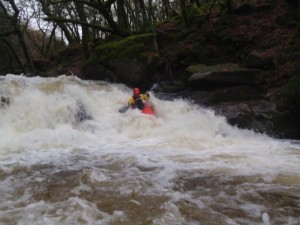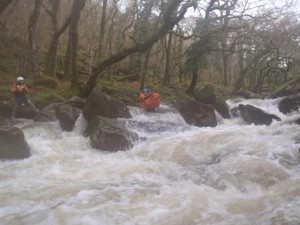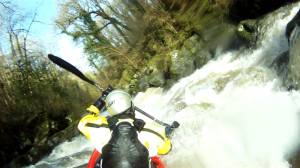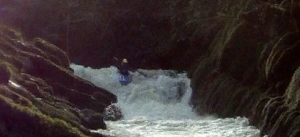My paddling highlight so far for 2013 has been a wet and cold January weekend in Dartmoor. Paddling with a good crew, we managed three excellent rivers with good water levels.
First up was the Upper Plym, a beautiful steep Grade 4 / 5 run that the guidebook calls the ‘jewel in the crown’ of English rivers. It has been on my list for a couple of years after I first saw it in spate back in 2009, when I paddled the lower few hundred meters of the upper and then the middle section with Rob Harris. Although the water level was more moderate this time, it produced all the right ingredients for a classic trip; the go / no-go discussion at the start, a combination of short and more extended rapids requiring tight boat control and plenty of nerve, and some intense moments involving throw bags. I was reminded of how fully alive I feel on a committing river. Maybe it’s the adrenaline, but everything becomes very clear and focused – a flow experience in many senses of the word.
Next up we headed over to Upper Dart, to find it running at a medium – high level. The Dart was full of snow-melt and felt significantly colder than the Plym. The last few times I’ve paddled the Upper it has been a scratchy bimble, and I’d forgotten how good it is with some water. It was a lot of fun this time – high enough to give all the rapids some power without feeling like we were getting into the trees. It was so good that Dean and Rob went straight back to the top for a second run. I was happy to call it a day at that point – I felt fully satisfied with two rivers in the day.
We retired to our bunkhouse for some down-time before heading to the pub, listening to the beautiful sound of overnight rain in Dartmoor. We had high hopes of catching the East Oakment the next day, as it was only a 20 minute drive from us and the rain was heavy. This is another steep classic, but it’s famously fickle. The Rainchasers website (http://www.rainchasers.com) told us we were good to go in the morning, but the sky was blue and the rain had stopped. So we watched the level of the East Oakment drop before our eyes on an I-pad as we ate breakfast in the pub. Note for next time – get up early and go if this river is running, don’t wait for breakfast!
So instead we headed north to the East Lynn, which was running a banker. Hila and Lucas decided not to paddle after finding their limits the day before, but we kept our numbers up with Arek and Bart joining us. The first section from the small village of Brendon was brilliant, with plenty of read and run Grade 4 and a harder rapid that deserved a look. We scouted a pushy two stage rapid, with a 2 + meter lead in fall followed by a narrow channel-like drop.
By the time we got to the gorge section our numbers had dropped, due to a combination of a tactical walk-out and Dean getting badly bruised on the big fall. The gorge was seriously impressive, with several hundred metres of Grade 4 -5 and a couple of must-make moves. Arek, Bart, Craig and I scouted it from the walking path high up on the right bank, but I’m not sure this was the best thing to do. It’s always hard to get an accurate sense of rapids from a distance like this, and we ended up erring on the side of caution and walking. The remainder of the river was bouncy and fun, with the high water allowing us to paddle all the way out into the sea at Lynton. We tried to surf the break, but it was big and lumpy. Although it was a great trip and we paddled some superb whitewater, I felt a little flat at the finish, without the same emotional high that I’d enjoyed after the Plym and Upper Dart.
The art of decision-making
Reflecting on this feeling later, I started to think about the importance of Decision-Making. In my sport psychology research I’ve identified Decision-Making as one of the fundamental skills that athletes (including river-runners) need. I think I made some good decisions on the weekend – for example choosing to walk around a couple of drops that were clogged with trees. On one S bend rapid on the East Lynn a tree had fallen half way across the river just at the lip of the second 1.5m drop. There was a line down the left, but any error would have led to a nasty encounter and a potentially lethal pin. No hesitation at all about walking that one. And I didn’t regret only taking only one run down the Upper Dart, because I was both satisfied and tired at that point, and there was only enough daylight left for a fast bolt down the river. But I was left with a nagging sense for several days that I had missed out by not paddling the East Lyn gorge.
At the time I felt 50 : 50 about paddling it. On the one hand I’d been paddling strongly, I could see the line all the way down, and I’d paddled the gorge before at lower levels. On the opposing argument, from the bank the rapids looked a step up from the rest of the river, with serious consequences for getting off line. And I was starting to feel tired. It’s at moments like this that the group dynamic really kicks into play. It seemed that none of us wanted to influence anyone else, and there was a range of views from definitely yes, maybe to definitely no. We were a new team, not having all paddled together before, so there wasn’t a lot of shared experience to call on. I found it hard to make a clear decision, and went from 50: 50 to 51:49.
Decision-making is all about balancing the risk and reward. The higher the risk, the greater the emotional reward when things go well. I’ll never know what would have happened if I had chosen to paddle the gorge. I may well have made the lines and ended the trip exhilarated, satisfied, buzzing even. Or I may have messed up, taken a swim, or worse. So on one level, my decision not to paddle the gorge was a sound one. The proof is that I’m sitting here safely at home in one piece. Yet that nagging question in my mind reminded me that it’s hard to always get this right, sometimes biting off too much, other times not pushing enough. The challenge never fades, because each river is different and I’m different each time I paddle.
It’s why I love whitewater so much.
Add your comments here and stay in touch via the Facebook page






